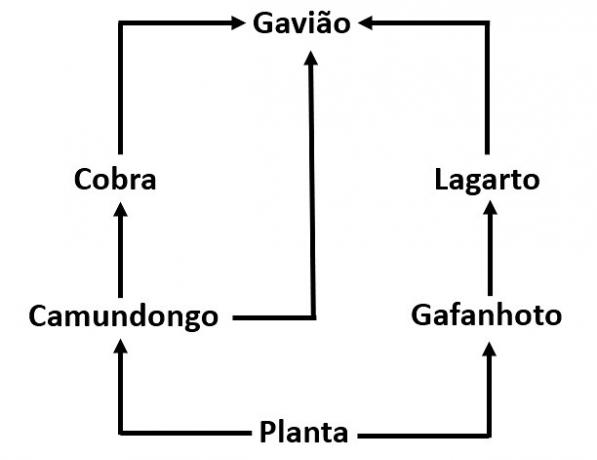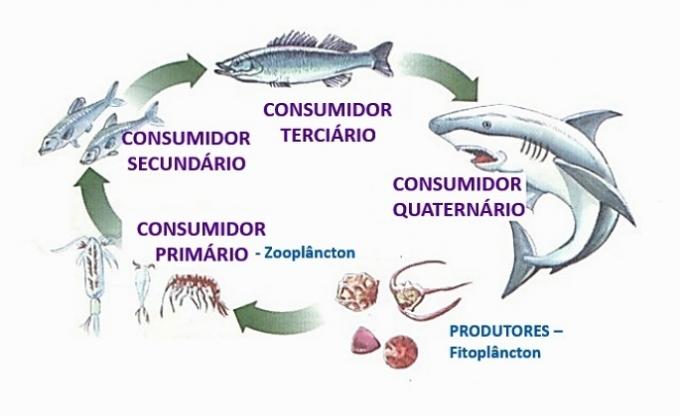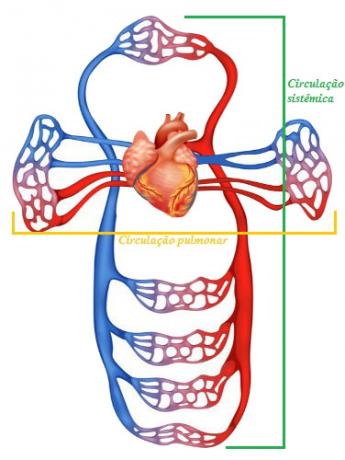Test your knowledge with the 12 questions next on the food chain. Also check the comments after the feedback to answer your questions about the topic.
question 1
Review the statements below and with reference to the food chain mark the correct alternative.
a) The food chain is responsible for carrying matter and energy along different paths, regardless of the beings that participate in it.
b) The food chain corresponds to the transformation of nutrients as one being serves as food for another.
c) The food chain consists of the transfer of matter and energy in a linear sequence, which starts with producing beings and ends with decomposing beings.
d) The food chain causes the accumulation of matter and energy in the passage through each trophic level, being greater in the last element of the sequence.
Correct alternative: c) The food chain consists of the transfer of matter and energy in a linear sequence, which starts with producing beings and ends with decomposing beings.
The food chain is a unidirectional transfer of matter and energy, as living beings absorb nutrients and energy when one feeds on the other.
This process is essential for the survival of living beings, as it is through food that the energy needed to perform their activities is obtained.
question 2
Food chains are not exclusive to certain trophic relationships, they can intersect and, therefore, create more complex sets called
a) Biosphere
b) Ecosystems
c) Food webs
d) Ecological pyramids
Correct alternative: c) Food webs.
In an ecosystem, food chains interconnect and form more complex sets called food webs.
While food chains can be basically characterized as food relationships between certain beings and, therefore, a unidirectional flow of matter and energy, food webs have an interrelationship, as certain species may have a varied food and, therefore, participating in more than one trophic level, that is, more than one way to acquire energy through food.
The other definitions are:
Biosphere: bringing together all the ecosystems existing on the planet.
Ecosystem: set of communities formed by living organisms and their physical and chemical environments, which interact in a given space.
Ecological pyramids: graphic representation of trophic interactions between species in a community.
question 3
Regardless of the food chain analyzed, they all have something in common: food chains always start with producing beings and end with decomposing beings. Justify this statement.
Reply:
Producers capture from the environment the resources necessary for their nutrition and, later, these beings will serve as food for others components of the chain until the death of an individual in the system causes organic matter and energy to be returned to the environment by beings. decomposers.
Producers introduce energy into the chain. For example, photosynthesizing producers capture light energy and store it in the form of chemical energy, that is, in the bonds that make up the molecules produced.
When a living being completes its life cycle, decomposing beings, such as fungi and bacteria, will decompose the organic matter and thus carry out recycling, which introduces the matter into the environment.
question 4
Correctly relate the components of a food chain with their respective characteristics.
Components of the food chain
I. Producers
II. Consumers
III. Decomposers
Features
The. They are beings responsible for returning matter to the environment.
B. They are beings called heterotrophs and one of the ways to obtain energy corresponds to the consumption of autotrophic beings.
ç. Beings that produce their own food through processes such as photosynthesis and chemosynthesis
The correct sequence is:
a) I.c; II.a; III.b
b) A.a; II.b; III.c
c) I.c; II.b; III.a
d) I.b; II.a; III.c
Correct alternative: c) I.c; II.b; III.a.
Producers are beings who produce their own food through processes such as photosynthesis, carried out by plants, and chemosynthesis, practiced by some bacteria that feed from the oxidation of compounds inorganics.
Consumers are beings called heterotrophs and one of the ways to obtain energy corresponds to consumption of autotrophic beings, that is, carried out by primary consumers who feed on beings producers. In addition, there are also secondary, tertiary, quaternary, fifth-order consumers and so on.
Decomposers, such as bacteria and fungi that live in soil and water, are responsible for recycling organic matter in the food chain.
question 5
The hierarchy of beings in a food chain is called trophic levels. The first level is formed by producing beings, capable of producing their own food and that is why they are called
a) homotypics
b) autotrophs
c) heterotrophs
d) heterotypic
Correct alternative: b) autotrophs.
The first trophic level of the food chain is occupied by producing beings, also called autotrophs, which are capable of producing their own food.
For example, plants are producing beings that capture nutrients and light energy from the sun to produce energy through photosynthesis.
question 6
In the plant → grasshopper → frog → snake → fungi and bacteria food chain, the frog participates in the transfer of energy as
a) First order consumer
b) Secondary consumer
c) Primary consumer
d) Third order consumer
Correct alternative: b) Secondary consumer.
The food chain corresponds to the sequence where one being serves as food for another and the arrows indicate the direction of energy flow. Plants are the first components of the chain because they are the producers and serve as food for locusts, which are primary consumers. Next is the frog, which is the chain's secondary consumer.
Toads serve as food for snakes, which correspond to tertiary consumers and when the die chain components will serve as food for decomposers, fungi and bacteria, ending the cycle.
question 7
In a community, trophic relationships are represented through ecological pyramids. These graphic illustrations are important to verify the transfer of matter and energy.
Ecological pyramids can be of three main types:
a) primary, secondary and tertiary
b) first order, second order and third order
c) number, biomass and energy
d) intraspecific, interspecific and mutualistic
Correct alternative: c) number, biomass and energy.
Number pyramid: displays the number of individuals in each trophic level and, consequently, the number of individuals in a food chain.
Biomass pyramid: shows the amount of organic matter distributed in individuals at each trophic level.
Energy Pyramid: presents the energetic magnitude, that is, the energy distribution in each trophic level.
question 8
The jaguar is the largest feline in the Americas and is threatened with extinction. The situation was further aggravated by the recent fires in the Pantanal, which directly affected this species, as they were affected by fire, and indirectly by the scarcity of water and food.
Jaguars, which are at the top of the food chain, are able to control the population of animals belonging to lower trophic levels, as
a) They are heterotrophic beings and exclusively secondary consumers.
b) They are carnivorous beings and have a varied diet.
c) They are consumers and have herbivores as prey.
d) They are consumers and predators of most animals in the biome.
Correct alternative: b) They are carnivorous beings and have a varied diet.
Jaguars are predators that feed on different animals that are part of the Pantanal biome, such as monkey, capybara, pampas deer, peccary and alligator.
Thus, these cats have an important ecological function, which is to prevent the increase in the number of animals below their trophic level (prey).
question 9
(UNESP) Note the diagram below, which specifies a food web and the beings that participate in it.

a) Which element belongs to more than one trophic level in the web presented?
Correct answer: Hawk.
When feeding on a mouse, it is a secondary consumer:
plant → mouse → hawk.
When feeding on a snake or a lizard, it is a tertiary consumer:
plant → mouse → snake → hawk
plant → grasshopper → lizard → hawk

b) What role does the plant play in this web?
Correct answer: producer.
The plant is the element that introduces energy into the chain, as it is an autotrophic being that captures from the environment what it needs to survive and will serve as food for a consumer in the chain.
question 10
(CESGRANRIO) With the elements, guinea pig, grass, snake and, now, adding fungi and soil bacteria, look carefully at the diagram below. Not neglecting the direction of the arrows and the numerical sequence, indicate the correct alternative in the sequence of events.

a) I - Producer, II - decomposer, III - primary consumer, IV - secondary consumer.
b) I - Producer, II - secondary consumer, III - decomposer, IV - primary consumer.
c) I - Producer, II - primary consumer, III - secondary consumer, IV - decomposer.
d) I - Decomposer, II - primary consumer, III - secondary consumer, IV - producer.
e) I - Decomposer, II - producer, III - primary consumer, IV - secondary consumer.
Correct alternative: e) I - Decomposer, II - producer, III - primary consumer, IV - secondary consumer.
I - Decomposer. Fungi and bacteria feed on beings that end their life cycle. The organic matter that formed these beings is degraded by decomposers, which release nutrients and mineral salts into the soil and will be used by producers.
II - Producer. Plants are producing beings that take from the environment what they need to produce their own food.
III - Primary consumer. The cavy is a herbivorous animal, that is, it feeds on autotrophic beings. When feeding on plants, he is a primary consumer in the chain.
IV - Secondary consumer. Cobra is a secondary consumer in the chain, as it feeds on cavy.

question 11
(UEMS) In the Pantanal there is a large number of aquatic ecosystems, formed by rivers, lakes and floodable areas. Phytoplankton is given to the community of microscopic algae that grow abundantly in these environments. These organisms perform in their ecosystems the function of:
a) primary consumers
b) secondary consumers
c) tertiary consumers
d) primary producers
e) decomposers
Correct alternative: d) primary producers.
In the aquatic environment, phytoplankton, a set of microorganisms and photosynthesizers, is the main producer. Among its functions, this type of algae converts inorganic matter into organic matter and oxygen, which are important for the aquatic ecosystem.
See the phytoplankton position in the chain below.

question 12
(UDESC) Analyze the propositions below regarding energy in ecosystems.
I. Photosynthetic organisms (such as algae and plants) are capable of capturing the light energy of the Sun and converting it into chemical energy, which is stored in the molecules of organic substances. This process is called photosynthesis;
II. In a food chain, the amount of energy at a trophic level is always greater than the energy that can be transferred. to the next level, since all living beings consume part of the energy of food to maintain their own life;
III. The transfer of energy in the food chain is unidirectional: it starts with the producing organisms, passes on to the consumers and ends with the decomposing organisms;
IV. Primary consumers obtain the energy necessary for their survival by feeding directly on photosynthetic organisms;
V. Decomposing organisms obtain the energy necessary for their survival through the decomposition of dead organic matter.
Check the correct alternative.
a) Only statements I, IV and V are true.
b) Only statements III and IV are true.
c) Only statements II, III and V are true.
d) Only statements I, II and V are true.
e) All statements are true.
Correct alternative: e) All statements are true.
I. TRUE. Chlorophyllated beings, such as plants and algae, carry out photosynthesis in regions of the cell called the chloroplasts, where chlorophyll is located, a pigment capable of absorbing light energy from the Sun. In this process, the bonds of water molecules and carbon dioxide are broken to produce oxygen, glucose and more water.
II. TRUE. The energy stored in the bonds that form the organic molecules produced are used by the elements in the chain. However, only a small amount of energy is transferred to the next trophic level, as a large part is used by the being in the chain to carry out their activities.
III. TRUE. Photosynthetic organisms are autotrophic beings and occupy the first level of the chain, as they are the introducers of matter and energy. Primary consumers are the elements that feed directly from the producers.
IV. TRUE. The decomposition process is carried out by bacteria and fungi, which feed on the remains of beings that have ended their life cycle. By breaking down organic matter, they feed and introduce salts and nutrients into the soil.
Get more knowledge with the contents:
- Food chain
- food webs
- Trophic levels
- ecological pyramids

